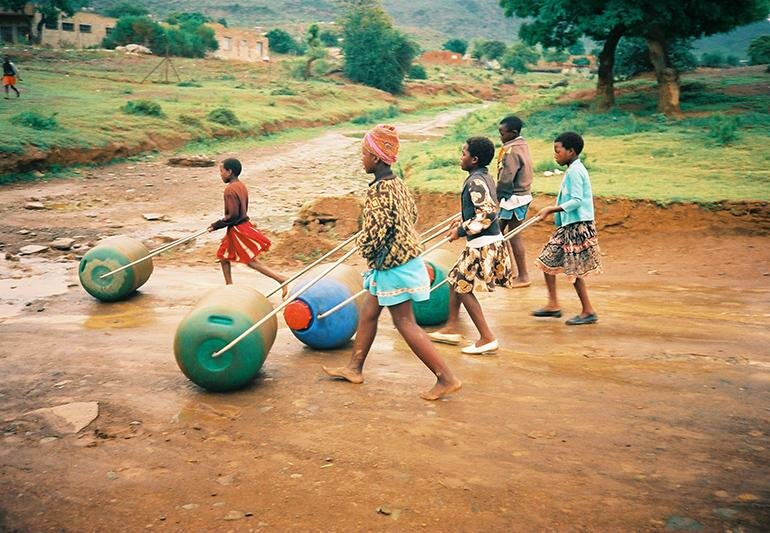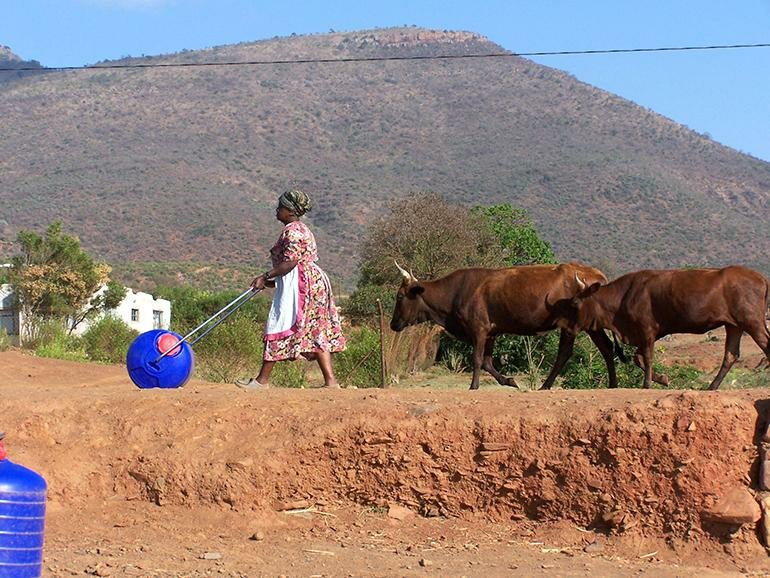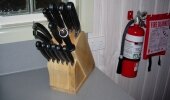Words: Laura Rigby & Grant Gibbs | Photos: Grant Gibbs
For many of us, the idea of collecting water is as simple as walking a few metres and turning on a tap. But for millions of people living in rural areas in South Africa, accessing water on a daily basis translates into a strenuous and time-consuming struggle.

The collection of water is seen by men as a menial task, and mostly left to the women and children. Although women are proud to be skilled enough to carry large buckets of water on their heads - something the men cannot do, as this is a skill learnt from a young age - the physical effort and strain to do this has far-reaching effects. First, one cannot carry much water at one time. A standard 20-litre bucket translates to 20 kilogrammes, which is a heavy burden to carry on a person’s head, especially when walking on uneven ground over long distances. Second, to collect enough water for the household each day, many trips are required and this is very time-consuming. Typical distances travelled range between 500 metres to 10 kilometres. Not only do women have less time to attend to other tasks around the home, children often miss school as they spend many hours queuing at water points and collecting water. This all has a spin-off effect on their quality of life, and ultimately keeps them in a position where they are unable to break free of the poverty cycle.
Recommended quantity
The South African Government standard for an acceptable number of litres that should be made available per person, per day, is 25 litres. In South Africa, most rural households have an average of seven people living in them and this means that they require at least 175 litres a day to lead a healthy lifestyle. Remember, water is not only required for drinking but also for maintaining hygiene and various other uses in the home, not to mention sustainable agriculture. Therefore, to break free of the poverty cycle, a person must first be able to solve the most basic human need of access to water. By solving this, women will have more time to seek employment, and children will able to attend school regularly and receive a proper education, and the entire family will enjoy improved health and wealth.

Transportation challenges
There are various ways in which water is transported from water points; namely buckets carried on the head (smaller ones for younger children, who then build up to 20-litre buckets), jerry cans, a combination of these in wheelbarrows, and large 200-litre drums. Although people in rural areas make the most with what they have, it is important to highlight the challenges faced when using these containers.
• Open buckets are unhygienic when carried over long distances, not to mention the devastation if you happen to trip and fall while carrying a bucket on your head - all the water is lost and you have to start the process all over again. Additionally, buckets without lids are left lying around the home and this poses a huge danger to babies and toddlers, who often fall into them and drown.
• Jerry cans can be closed with lids, but the openings are so small that the cans can’t be cleaned and eventually bacteria and algae build up, making the containers hazardous to one’s health.
• If a person is privileged enough to afford a wheelbarrow, then yes, they are able to transport much more water at one time. But because of the way in which a wheelbarrow is designed, when lifted by the handles, not only is the majority of the weight carried by the person but the wheelbarrow also becomes unsteady, as it has to be negotiated along rural terrain on one small thin wheel. On a side note, the pathways to rivers and boreholes become deeply eroded due to the narrow wheel of the wheelbarrows being used and this creates an even more difficult and treacherous pathway for people to travel.
• The 200-litre drums are quite expensive, even though they are able to carry enough water to last up to a week. However, imagine transporting a large drum of this size – just the water in the drum would weigh 200 kilogrammes. It takes a whole family to roll these drums back to the homestead, never mind the effort it takes, especially if the drum must be rolled up a steep hill.
• All these transport methods require a huge amount of energy.
Water points
In rural areas, water is accessed from multiple water points, depending on the season as the water table changes. Most often, you will find that water is collected from a few different points, such as a river, borehole, or single village tap. However, it must be pointed out that even though some areas do have a certain level of infrastructure, it often does not work due to the lack of maintenance, pumps and pipes being stolen, piped water only being available once a week through a single tap, or being trucked in by the water authorities.
Although South Africa is one of the very few countries that enshrine the basic right to water in its constitution, the idea of making piped water available in rural and informal homes in the near future is an unrealistic one. Interim solutions need to be identified to realise this goal.
Improved access
The need for improved access to water is massive, not only in South Africa but around the world. The UN quotes that more than one billion people (or one in six) do not have adequate access to water. As human beings, it is all of our responsibility to assist those in need with the most basic requirement for life. Next time you open the tap, water your garden, or flush the toilet, think of those who have to struggle daily for this privilege.
A simple solution
Fortunately, a South African-designed product offers a simple and appropriate solution to this ever-increasing need. The Hippo Water Roller, designed by Johan Jonker and Pettie Petzer in 1991, is a barrel-shaped container, with a steel handle, that allows for 90 litres of water to be pushed along the ground. As the container is the ‘wheel’, all the weight is on the ground, thus making it extremely easy to push, even for children. The steel handle is designed in such a way that the roller can be pushed or pulled, and two people can walk side-by-side and pull it up a steep hill. The actual container is made in a single, solid piece and purposely designed with rural conditions in mind so that it moves easily over tough terrain. It can even assist with preventing erosion, by compacting the soil as it rolls. The average lifespan of a roller is five to seven years and some have been used for up to ten years. To date, more than 42,000 Hippo Water Rollers have been distributed, directly benefiting more than 300,000 people. Without the assistance of sponsors and donors, this would not have been possible.
Help us to reduce this daily struggle experienced by millions in South Africa and other developing countries, so that they too can have access to the most basic requirement for life. •
dinFO
For more information on the Hippo Water Roller Project or to become a sponsor, please visit www.hipporoller.org











